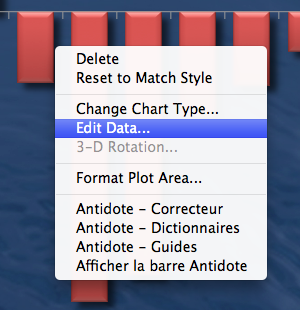PowerPoint 2011: Editing charts in Excel is a maddening process
Posted by Pierre Igot in: MicrosoftOctober 28th, 2012 • 3:37 pm
Editing PowerPoint slides with PowerPoint 2011 is absolutely maddening. As a professional translator, I sometimes have no choice but to work directly in PowerPoint, and each time I end up exceeding my frustration quota because of PowerPoint 2011’s sheer crappiness.
I’ve already written about PowerPoint flaws in the past. Each time I use the application, I find new ones to add to the list.
Today, I’d like to describe what happens when a PowerPoint slide contains a chart and you try to edit it. Typically, if the chart is editable, you can control-click or right-click on it to bring up a contextual menu:

Selecting the “” menu command in this menu automatically opens the source data for the chart in Excel. But the first maddening thing happens right away: Excel automatically zooms the window containing the data so that it fills your entire screen. On a 30″ monitor (and even on smaller monitors), it’s an absolutely ridiculous waste of screen real-estate and forces you to resize the window each and every time — which is particularly important because of the second major flaw in Excel when editing charts from PowerPoint.
That second flaw is that each edit that you make in Excel causes some kind of interaction with PowerPoint during which Excel becomes entirely unresponsive and ignores your keystrokes. Once the interaction is over (which can take anywhere from a fraction of a second to several seconds for a complex chart), the contents of the chart in the PowerPoint slide in the background are updated to reflect the edits that you made, and you can resume typing in Excel to make further changes. But any keystrokes made during the interaction are completely ignored and lost. They are not stored in some kind of buffer and entered in a spurt once the user regains control of Excel. No, they are simply lost.
It’s an infuriating flaw, because you have no idea when the interaction starts and stops (there is no change in the cursor). The only visual feedback you get is the change in the PowerPoint slide in the background, which you can only see if you resize the window in Excel that is zoomed to fill your entire screen by default!
The flaw even extends to mouse clicks. Anything the user tries to do in Excel during these interactions is lost. It completely breaks the flow of one’s work, and it’s impossible to avoid losing keystrokes and mouse gestures, and having to repeat them once you see that Excel didn’t register them. It drives me insane.
This only occurs when editing charts open from within PowerPoint. Otherwise, Excel works just fine. But when it used as an editor in a way that is linked to a chart in PowerPoint, it is impossible to avoid having to deal with the unpredictable periods of unresponsiveness during which Excel ignores and loses all user interactions with the data sheet.
I am tired of having to put up with this crap, but I have little choice. I suppose I could try working in a Windows version of PowerPoint under VMWare, but this would force me to purchase more Microsoft crap, and would deprive me of the use of tools such as Typinator, which at least makes text input somewhat less painful in Microsoft applications and in PowerPoint 2011 in particular.
There are many other maddening aspects in PowerPoint 2011. The constant disappearance of the blinking I-beam cursor while typing or using keyboard shortcuts for text navigation is another one. It’s a chronic problem that has plagued Microsoft applications for Mac OS X for years, and it’s particularly prominent in PowerPoint 2011, when editing text in text boxes. I constantly have to deal with the fact that I cannot see the I-beam cursor and therefore do not know exactly where I am in the text until I pause my typing just to allow PowerPoint to “catch up” with me and start blinking its cursor again.
What a piece of crap.